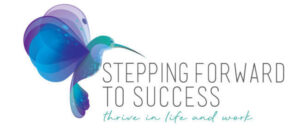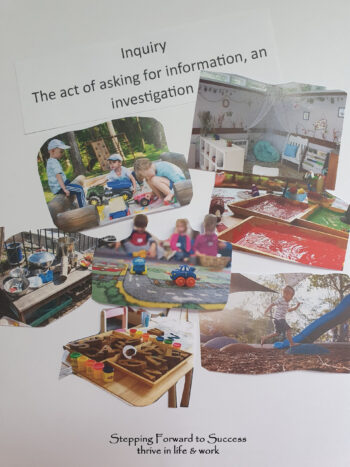Inquiry will be a big part of your provisional teaching journey.
As you know, you can complete several inquiry studies during this time.
Inquiries should not stop there.
The work you do for those Inquiry topics can be used to positively influence your teaching practices throughout your career.
Let’s take some time to unpack the Inquiry Cycle and how you can maximise the benefits of the work you do long term.
What Is The Inquiry Cycle?

The Inquiry Cycle allows you as a teacher to inquire into the impact your teaching practices have on the children’s learning and helps you to make decisions to improve those practices.
The Inquiry Cycle follows five steps:
1: Notice
The first step is to notice an area in your teaching practice or at your centre that you want to enhance. You can do that by reflecting on and questioning your current practices and keeping your eyes open at your centre.
Consider what learning is happening for children, the opportunities and challenges within your centre, any areas from the Code of Standards you’d like to enhance, or where you can improve the children’s experience.
Don’t forget to check what Inquiries have previously been done in your areas of interest and how you might be able to build on them for your own Inquiry.
2: Form An Inquiry Focus
After deciding what you are going to focus on for your Inquiry, it’s time to form a specific focus. Specific is the keyword here. By keeping your focus specific, you will make your Inquiry manageable. Being able to break the Inquiry down into 4-5 strategies is ideal.
At this stage of the Inquiry cycle, you are exploring ideas. Your Inquiry question is not set in concrete, though it provides you with directions to begin researching.
Consider what is most important and worth spending time on and what priorities you should have to create productive outcomes for the children and your ongoing teaching practices. Focus on areas where you have influence and can create change, no matter how small.
It’s also good to explore if your team members are working on a similar area as you may be able to collaborate and maximise the return of your Inquiries.
3: Gather Evidence And Reflect
With an inquiry focus in mind, it is time to gather evidence and reflect. The first step is to collect information on your focus area to clarify what is currently happening. Look into learning stories, centre reviews, meeting minutes and within collaborative discussions.
Assess what is working well and if there are aspects of your teaching that you can enhance. How can you make a difference in the children’s learning and what do you need to learn in order to make that happen? Consider any barriers and how you might overcome them, and who you might connect with for support and guidance.
Finally, think about how and where you can learn more about the actions you need to take. Be open minded in your evidence gathering and think beyond the obvious solutions. Utilise readings, research, resources, and experts to expand your thinking.
After engaging in reflective practice, you may want to revisit and tweak your inquiry focus.
4: Plan And Implement Changes
After gathering your evidence and reflecting on current practices, it’s time to create a plan so that you can achieve the change set out in your Inquiry Focus. Decide what changes you’d like to see over time so you can assess whether your consistent actions are making a difference.
Be clear about what you want to achieve, but give yourself a manageable timeframe to do it. Don’t forget that you aren’t alone in this, in fact, you will get even more out of the Inquiry Cycle if you can find ways to incorporate peer observation and discussion.
As you work through your plan, explore what learning has happened and look at ways you can keep moving forward. If needed, make adjustments and refocus so that you can still achieve your intended outcomes.
5: Evaluate – Thoughts For The Future
A key part of the Inquiry Cycle is evaluation. Review what happened as a result of the change you created and what implications it has had on your teaching practices. Consider how you made a difference as this can inform where your Inquiry might go next.
Take the time to evaluate the positive changes you have made in your teaching practice, the new learnings you have gathered and how that can translate into ideas for the future.
Maximising The Inquiry Benefits
Now that you understand the key components of the Inquiry Cycle, you want to make sure you are maximising the benefits you receive from the process.
Working through Inquiries is a necessary part of obtaining your teacher certification. But, that does not mean you should simply go through the motions to get them signed off. You can create really valuable learnings for yourself and positive change within your centre during this process.
Maximise this opportunity by immersing yourself in the process. Though, don’t try to act alone. Your mentor and centre colleagues will have invaluable insights that can help you go further and deeper with your Inquiry.
If you feel you need further support, then I’d love to be the one to partner with you on your teaching journey. As a trained ECE coach and Mentor with more than 30 years of experience in the education sector, I can provide an external perspective and objective advice on how to maximise your Inquiries.
If you would like to make the process of working through your inquiries smoother, keep a look out for “A Guide to Implementing Teaching Inquiry,” a resource to support inquiry focuses. It will be available for purchase soon.
Or feel free to reach out and book a time to chat with me to see if you would benefit from my support and expertise. Here’s the link to book: leanne@steppingforwardtosuccess.co.nz
Useful links:
My Website

